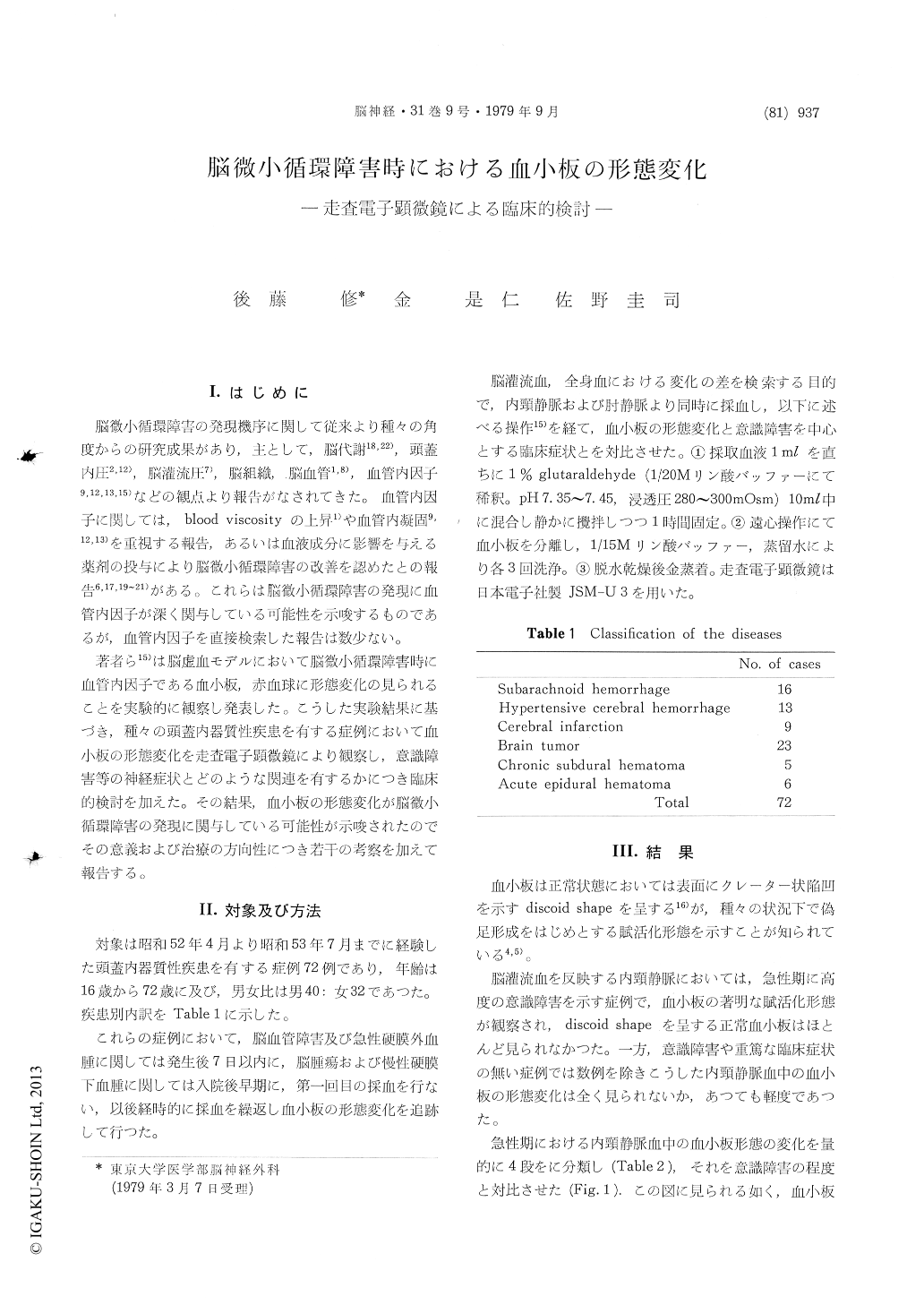Japanese
English
- 有料閲覧
- Abstract 文献概要
- 1ページ目 Look Inside
1.はじめに
脳微小循環障害の発現機序に関して従来より種々の角度からの研究成果があり,主として,脳代謝18,22),頭蓋内圧2,12),脳灌流圧7),脳組織,脳血管1,8),血管内因子9,12,13,15)などの観点より報告がなされてきた。血管内囚子に関しては,blood viscosityの上昇1)や血管内凝固9,12,13)を重視する報告,あるいは血液成分に影響を与える薬剤の投与により脳微小循環障害の改善を認めたとの報告6,17,19〜21)がある。これらは脳微小循環障害の発現に血管内因子が深く関与している可能性を示唆するものであるが,血管内因子を直接検索した報告は数少ない。
著者ら15)は脳虚血モデルにおいて脳微小循環障害時に血管内因子である血小板,赤血球に形態変化の見られることを実験的に観察し発表した。こうした実験結果に基づき,種々の頭蓋内器質性疾患を有する症例において血小板の形態変化を走査電子顕微鏡により観察し,意識障害等の神経症状とどのような関連を有するかにつき臨床的検討を加えた。その結果,血小板の形態変化が脳微小循環障害の発現に関与している可能性が示唆されたのでその意義および治療の方向性につき若干の考察を加えて報告する。
Many factors are known that contribute to the pathogenesis of the cerebral microcirculatory dis-turbances, but, there are few reports investigating the roles of the intravascular components directly. The present study was undertaken to evaluate morphological changes of platelets in patients with cerebral damage, in relation to neurological signs, especially consciousness levels.
Morphological changes of platelets were observed in 72 patients with intracranial organic lesions. These lesions included subarachnoid hemorrhages, hypertensive cerebral hemorrhages, cerebral infarctions, brain tumors, chronic subdural hematomas, and acute epidural hematomas.
Two blood samples were taken, one from the internal jugular vein (the blood after cerebral perfusion), the other from the cubital vein (systemic blood). After fixative procedures with 1% glutaraldehyde, the differences in the three-dimensional structures of platelets were compared, using a scanning electron microscope.
In general, remarkably activated forms of platelets were found in the blood after cerebral perfusion in cases with severely impaired consciousness in the acute stage. But, in cases without severe neurological deficits, such changes of platelet forms were rarely seen. A close relationship was sug-gested between the degree of neurological damage (especially consciousness levels) and that of platelet activaion in the acute stage. In the chronic stage, these changes of platelets in the cerebral blood disappeared. Changes of platelet forms were not found in the systemic blood from the cubital vein, even in the acute stage.
It is clinically suggested that morphological changes of platelets play an important role in the pathogenesis of the disturbed cerebral micro-circulation. Obstruction of cerebral microvascu-lature may be caused, mechanically by the activated platelets themselves, and/or chemically by vaso-constrictive substances released from these platelets. Therefore, in the treatment of these intracranial organic lesions, it is concluded that the possible roles of activated platelets should be taken into consideration.

Copyright © 1979, Igaku-Shoin Ltd. All rights reserved.


